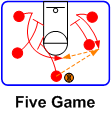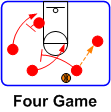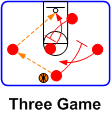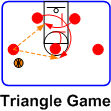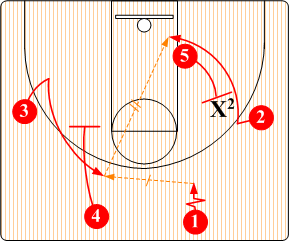- Offensive Techniques & Strategies
Passing Game
What to Discover or Recall:
If you are interested in employing a Passing Game offense, you will probably have to readjust your offensive thinking and philosophy.
Passing game action controls the offense using basic rules and principles rather than concentrating on executing set patterns or plays.
With the primary emphasis of off ball screens and movement, all players are involved in the offense at all times as compared to pattern or set plays that only involve two or three players at one time.
However, there is nothing in pattern or set offenses that cannot be incorporated in the passing game. It can be run out of a variety of alignments according to specific player personnel available. The passing game can also be equally effective against zones as well as person to person defenses.
Passing Game Offense
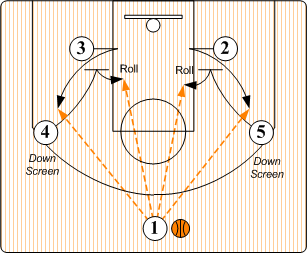
| Basic Rules | Variations | Fundamentals | Zone Adjustments | Commitment |
Team Effort & Attitude
Since the Passing Game is a team oriented offense, players must develop an unselfish attitude and work hard to create open shots opportunities for their teammates. "Nothing creates more problems for the defense than movement." Therefore, with the Passing Game offense, it is imperative to make the defense work hard by having patience and controlling the ball. To be successful, however, each offensive movement must have a definite purpose such as to create a lead, make a sharp basket cut, set a screen, or establish rebounding position.
Passing Game Strengths
All Five offensive players are involved at all times.
Provides good ball and player movement.
Continuous motion eliminates having to set up.
Provides players with freedom and creativity.
Effective against all types of defense.
Having no set pattern makes it hard to scout and prepare for.
Can control game tempo.
Passing Game Weaknesses
Selfish and exceptional offensive players will break down continuity
Offensive rebounding
Players are not skilled in reading and countering defensive tactics.
Players are not patience in creating good shots.
Players do not like to play without the ball.
Passing Game Variations
There is nothing in pattern or set offenses that cannot be incorporated in the passing game. It can be run out of a variety of alignments according to specific player personnel available. The passing game can equally be effective against zones as well as person to person defenses.
Click on desired variation above to view graphically Illustrated details.

Required Individual Player Fundamentals
Since the Passing Game Offense gives players the freedom to create, it requires a real commitment on the part of the basketball coach to teach basic offensive skills (shooting, passing, screening & rebounding). For the Passing Game offense be successful, all players must have a working knowledge of the following offensive fundamentals and principles:
Moving the Basketball
Take pride and develop passing skills.
Make sharp , accurate passes.
Create a lead and get open before receiving the ball.
Developing offensive patience and shot discipline.
Maintaining proper 15-18 foot spacing.Comprehending and Taking Good Shots
Rely on teamwork to obtain good shots.
Players must be aware and adhere to their shooting range and scoring abilities.
Receive the ball in a triple threat position.
Employ the good shooting techniques and form ("BEEF").Moving with a Purpose Without the Ball
Creating leads.
Making sharp basket cuts.
Setting and using strong screens.
Establishing inside rebounding position.Successfully Executing Off-Ball Screening Techniques
Setting up and using the screen effectively.
Setting proper screens.
Reading and attacking the defensive reactionsEliminating the Dribble except:
For a strong move to the basket.
To create a better passing angle.Developing a Strong Inside Game
Basic low post shots: power layup, baby hook, and turn and face.
Establishing strong post up position for two counts and calling for the ball.
Posting up and exploiting a weaker defender.Rebounding Offensively
Second efforts win championships.
Assume all shots are going to be missed and go get the ball.
Use screens (teamwork) and movement to establish inside rebounding position.
Cognizant of any defensive responsibilities.Reading (seeing) the Defense
Players must know where and how the defense is playing.
Pass away from defender rather than passing to offensive player.
Back cut against any defensive overplay.

Basic Rules & Guidelines
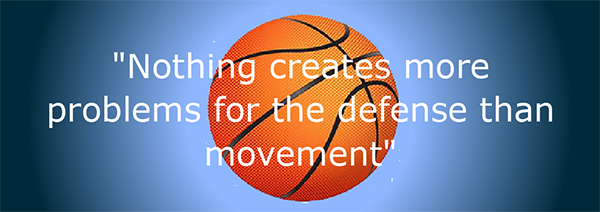
Since the Passing Game is an unstructured offense, it gives freedom to players to create; however, this freedom must be well coordinated within a framework of some basic rules and principles. Coaches should develop principles and rules that best fit their own specific situation. However, keep in mind that the rules must be kept simple. The more rules and restrictions put on players, the more pattern the offense will become.
| Pass & Move | Leads | Spacing | Screens | Cuts | Triple Threat | Post Ups| Rebound |
Eight Basic Rules

Movement creates opportunity. However, move with a purpose: Create a lead, make a sharp basket cut, set a screen, or establish rebounding position.
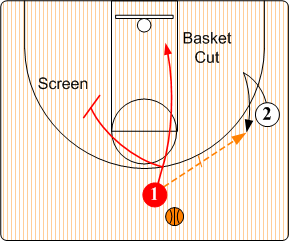
Step the defender down by taking the first step of a basket cut and read the defense. If the defender does not react, continue to the basket on a "Give & Go" cut. If the defense reacts screen away after passing.
Move the Ball
Caution: Never pass to a receiver that does not call for or want the ball.
- Make sharp, accurate passes. Get the ball to open players.
- Lead receivers into good shots. Pass away from defense to shooter's hand shoulder high.
- Eliminate the dribble except for a strong move to the basket or to create a better passing angle.
Raising Your Level of Passing - View Click Here

Timing is critical. If the receiver creates a lead too early or too late, it will be of no value. In order to achieve the proper timing between passer and receiver, when the ballhandler puts their off hand on ball, it initiates or "triggers" the action on the part of the receivers.
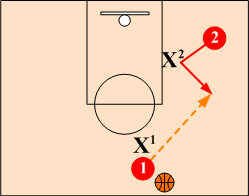
- Lead must be coordinate and timed with the point guard's arrival at a point 12 –15 feet away.
- "Center" and cut off tight on screens.
- Back cut to basket against defensive over play.
- Must present the passer with a target hand and call for the ball.
Creating Leads - View Click Here

The importance of meeting the pass cannot be over-emphasized. It is the receiver's responsibility to seal off the defender, maintain a position between the passer, and step out to meet the pass. "When the ball is in the air, the feet are in the air." In meeting the pass, it prevents the defender from stepping around and deflecting or intercepting the pass. However, in meeting the pass, it is important as the receiver to maintain proper court spacing.
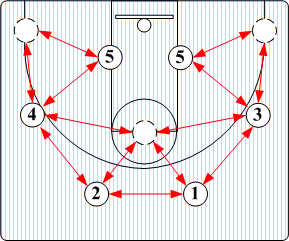
Most passes should be made within a 12' to 15' distance. This spacing spreads the defense and allows for quick, accurate passing.
Passes beyond 15' carry a high risk of interception. Never throw directly at a receiver moving away from you. Always lead the receiver to the basket.

CAUTION: It is the responsibility of the receiver to run their defender into the screen.
When setting a screen, execute a bent knee jump stop keeping arms tight to body. Maintain ball vision by looking over shoulder. Assume a solid, wide base screening position. Do not allow defender to push through. Be stationary and do not step out or lean at last moment.
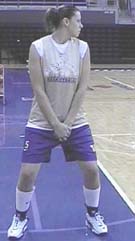
Be Set and Hold Screens
Being set and holding the screen not only makes the screen more effective; but it also reduces the chances of getting called for a moving or illegal screen.
Setting Solid Screens - View Click Here
Screener Reads & Options
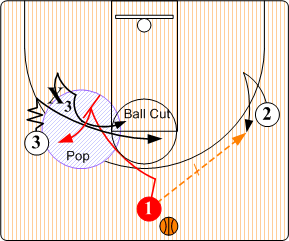
Screen & Pop
After setting a solid screen, make a reverse pivot and pop out to maintain proper spacing.
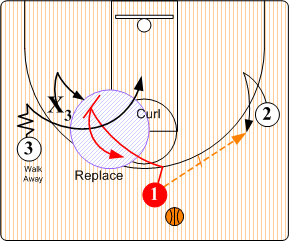
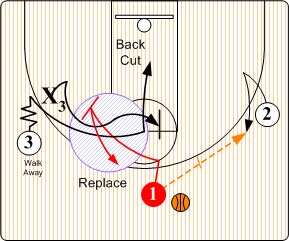
Screen & Replace
Replace to the ball any time the receiver cuts to the basket.
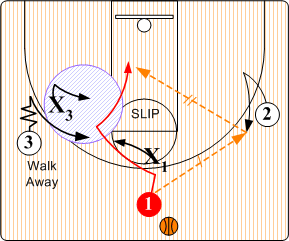
Slip the Screen
When the defense "Shows & Recovers" in combating the screen, the screener has the option of slipping the screen and cutting away directly to the basket.
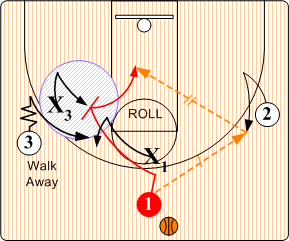
Screen & Roll
Against a switching defense, the screen has the option of rolling to the basket after setting the screen.

Setting Up Screens
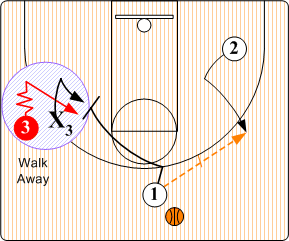
Set up screen by walking your defender away. If defender does not react make a strong back cut to the basket. wait until screen has been set before initiating action. The most common error in using a screen is moving BEFORE the screener can get set.
1. Ball Cut Option
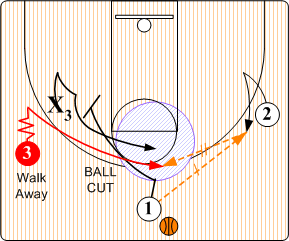
Set up screen by walking defender down, change direction and break shoulder to shoulder off screen to ball.
2. Curl Option
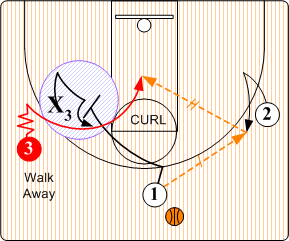
When the defender chases over the screen, it allows a receiver to cut to the basket for shot.
3. Fade Option
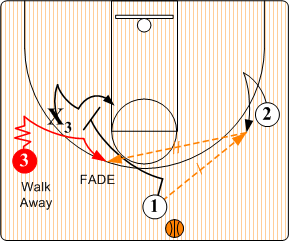
When the defender goes UNDER the screen, it allows a receiver to fade or V-cut for an open shot.
4. Back Cut Option
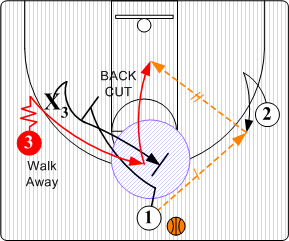
Counter any defensive overplay by making a strong cut to the basket (back door). Screener pivots and replaces cutter.
5. Early Back Cut Option
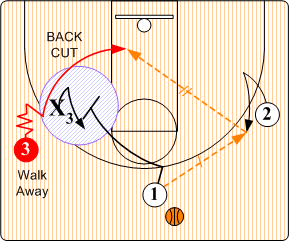
When the defender anticipates and CHEATS over the screen early, the receiver should back cut directly to the basket for easy shot.

"Hard to Guard" - The threat of the dribble, not the actual dribble, is what provides the offensive player with a big advantage over the defender.
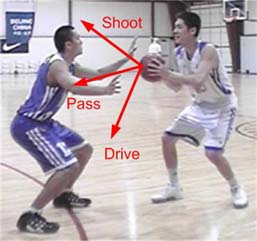
"Triple Threat" is a bent knee position with head and eyes up holding ball in a position to drive, pass or shoot.
Do not dribble unless to drive hard to the basket, to improve passing angle or to get out of trouble. To be most effective, get to the basket in one or two dribbles.
Analyze the Defensive Deployment
If the defense plays loose or sags off, look for open jump shots.
If the defense plays tight and does not switch, anticipate drives and back door cuts.
If the defense switches, expect screen and rolls, screen and pop, or slip screen opportunities
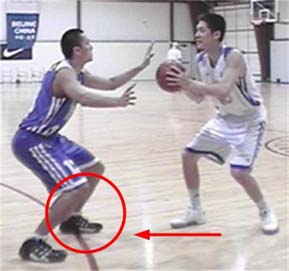
Attack Defender's "Up Foot"
Out of a triple threat position, attack the defender's foot closest to you on drives to basket.
Shot Selection
Know your shooting range. Strive to create and take shots that you work on in practice.
Do not hesitate to take and make open shots. Not taking a good shot can often times be worst than taking a bad shot.
On drives and basket cuts, take the ball strong to the basket and finish!
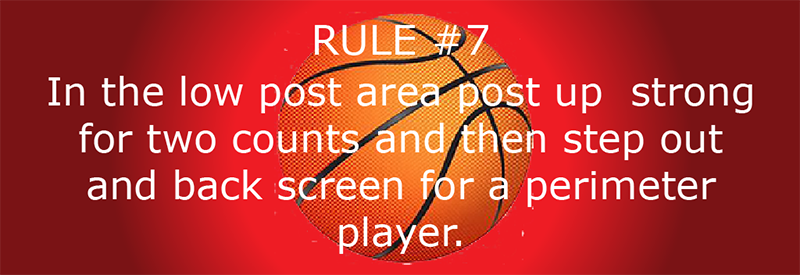
Posting up is a big part of the game of basketball. It is truly an advantage to have a dominant force inside. However, post ups are not limited to just big players, look to exploit size mismatches at any position. On mismatches is much better to take your defender inside than to go one on one outside. Therefore, all players, regardless of size, should be proficient in posting up strong and executing basic post moves. Posting up is a big part of the game of basketball.
Developing a Strong Inside Game - View Click Here

With the Passing Game, since shooters will most often receive the ball going away from the basket, offensive rebounding can be a problem. Therefore, offensive rebounding responsibilities and techniques must be stressed and practiced. Rather than size and strength that is required for defensive rebounding, offensive rebounding requires anticipation, determination, and hustle. Players must develop an attitude as well as an instinct for the ball. Be aggressive and determined. 2nd and 3rd efforts should be common place. Want the ball. Anticipate a missed shot and get inside. Do not ever stand behind and wait for rebound.
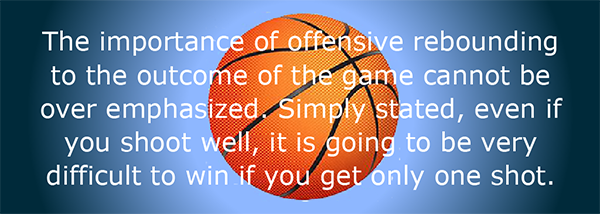
Box Out the Defenders

On the shot, establish inside position and box out the defenders.
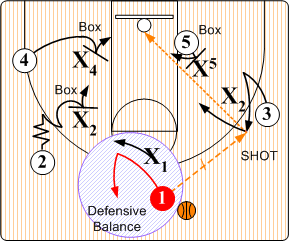
Maintain defensive balance responsibilities.
Arm Over/Step Over Move
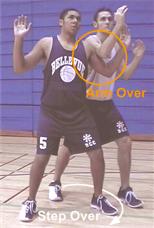
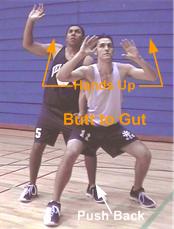
In cases where the defender does make an attempt to box out, the offensive player should deploy an Arm Over/Step Over move to establish inside position.
Offensive Rebounding Techniques - View Click Here

3 Person Passing Game
Hi/Lo Passing Game
The "Three Game" or "Hi/Lo" passing game is essentially a three out two in offense. Adhering to the basic passing game principles, the inside players play off each in basically two player actions while the outside players are in constant motion. The inside players also have option of setting screens for the outside players.
High/Low Feed
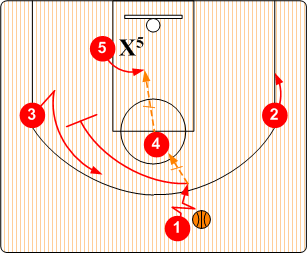
Whenever the ball is passed into a high post, the first look is for the shot and the second look is to feed the low post player flashing into the middle.
High/Low Feed
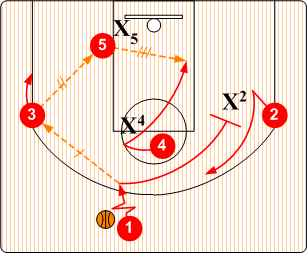
Whenever the ball is entered to the low post, the first look is for shot and second look is a pass to the opposite post player spotting up or rolling to the basket.
Down Screen
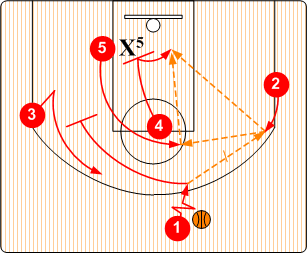
The passing game can be initiated with a down screens. High post O4 sets a down screen for O5 as O1 passes to O2 and screens away. O2 looks to feed O5 breaking up off O4's screen or, if the defense switches, looks to feed O4. When O5 receives the ball, O5 looks for shot and then to O4.
Back Screen
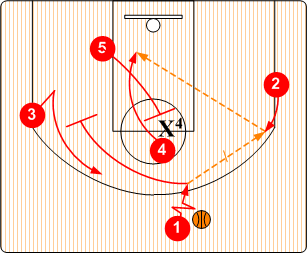
Low post O5 has option of stepping out and setting a back screen for O4.
Post Roll
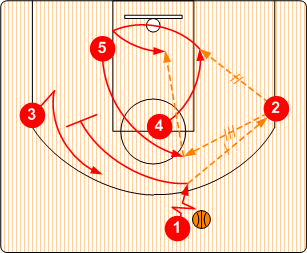
High post O4 has option of rolling to basket on O1's pass to wing O2. If O4 does not receive a pass, O4 goes out weakside. If O2 passes to O5 breaking up on O4's roll, O5 looks to feed O4 flashing into the middle.
Base Screen
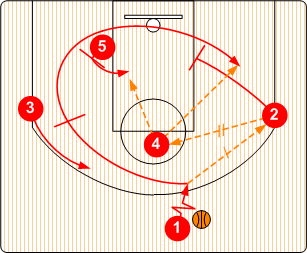
Post players also have option of setting screens for the outside players. In this example, O1 passes to wing O2 and screens away. O2 then makes a high post pass to O4 and sets a down screen. O1 cuts baseline off O5's base screen and O2's down screen. If/when the defense switches, O4 looks to feed O5 posting up against the smaller defender.
Mid Screen
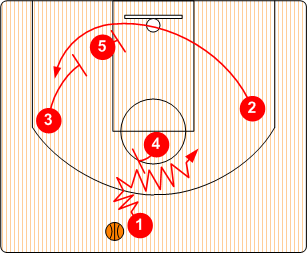
The Hi/Lo passing game action can be initiated with a mid screen. O2 clears weakside off O5's base screen and O3's down screen as O4 sets an on ball mid screen for ballhandler O1.
Side Screen
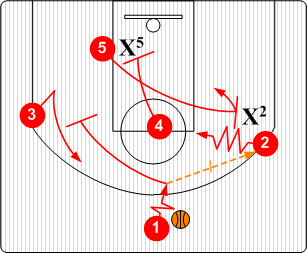
Either post player can also step out and set an on ball side screen at anytime.

4 Person Passing Game
Four Out
The four person passing game can be deploy in two ways: As a single post or as a rotating post. The single post is primarily used when a strong post-up player that you want to keep inside is available. In the four out passing game, all players rotate in and out of the post area. Posting up for two counts and then stepping out and setting a back screen.
| Post Back Screens | Various Entries |
Post Back Screen Action
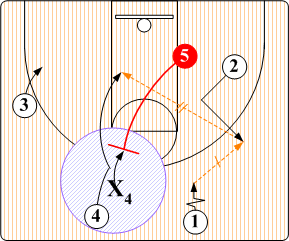
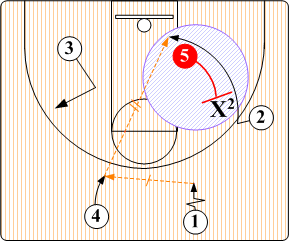
Anytime the post is fronted or cannot establish a strong post up position, they step out and set a back screen for any of the perimeter players. The player receiving the back screen cuts to the basket and becomes the post. Screener then replaces the cutter on the perimeter. All passing game rules apply.
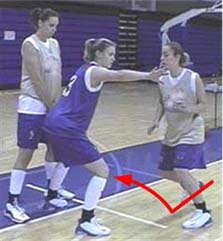
Using the Back Screen
Player receiving the back screen steps toward the ball, and then changes direction cutting to the basket off the back screen. Present passer a target hand. If the defender does not react to initial step, continue directly to ball.
Various Types of Entries
Since the Four Out passing game is unstructured, most any type of a pass or cut will initiate the action.
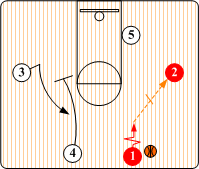
Pass Ahead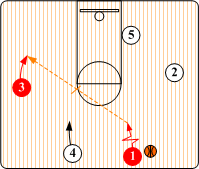
Skip Pass Ahead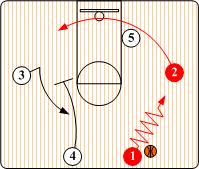
Dribble Clear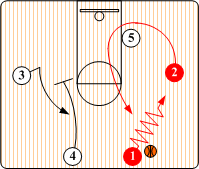
Dribble Curl (Zipper)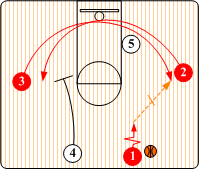
Base Cross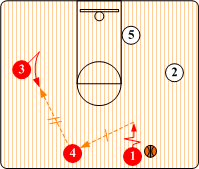
Ball Reversal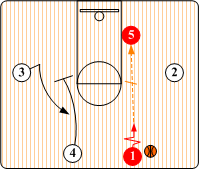
Post Direct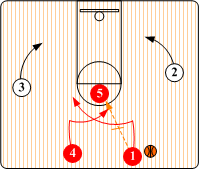
High Post Split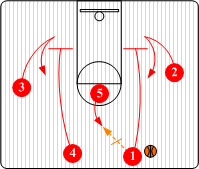
Post Pop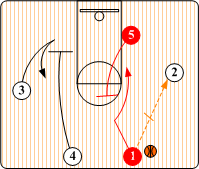
High Post Rub (UCLA)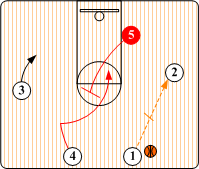
Hawk or Shuffle Cut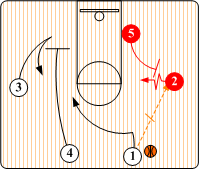
Side Screen

5 Person Passing Game
Motion
The five person passing game or motion is designed for a team of smaller, quicker players that are very athletic. The five player continuous movement allows for a lot on individual offensive freedom along with opening up the middle for penetration and cuts. Since there is no precise structure, player movement is very unpredictable and difficult to defend.
The five player passing game takes full advantage of sagging type defense since most shots will be face up, medium range created by setting down and base screens. There is very little posting up in the five person passing game. The middle is purposely kept open for drives and cuts to the basket. Any posting up that does occur is usually comes after a player sets a screen.
| Down Screen | Screen Away | Continuity | Double Screen | Isolation | Back Cuts | Drive & Drop | Drive & Kick |
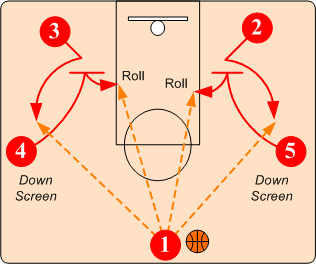
Down Screen Action
O4 and O5 set down screens for shooters O3 and O2 on baseline. Ball handler O1 has option of feeding O2 or O3 coming off the down screens or O4 and O5 posting up if the defense should switch.
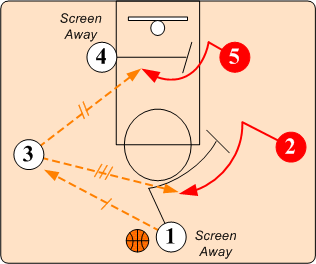
Screen Away Action
If/when O3 receives pass from point O1, O1 and O4 screen away. Wing O3 looks to feed O5 low or shooter O2 at the top of the circle.
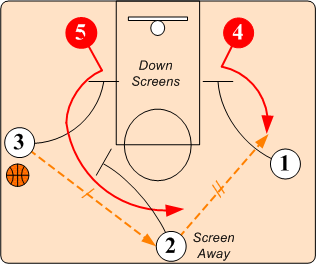
Ball Reversal - Continuity
Any time the ball is passed out to the top of the circle, wings screen down. When the player at the point passes to wing, they set a screen for the opposite wing.
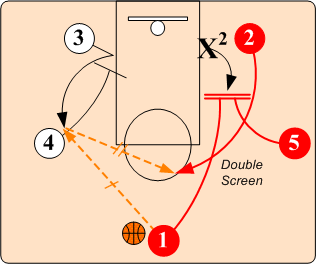
Double Screen Option
A double screen can be created by point passing to wing and screening down for opposite post.
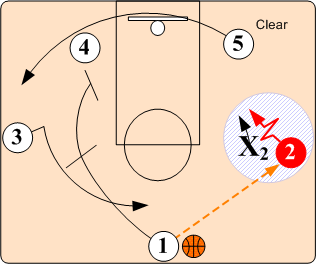
Wing Isolation
One-on-One wing isolations can be created at any time by the post clearing to opposite wing off O5's and O1's weakside double screen.
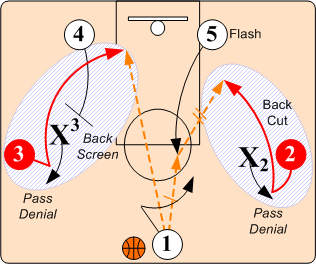
Back Cuts vs Overplay
If/when wings are over played and the pass from the point is denied, the post breaks high and wing back cuts to the basket for a back door feed. Post also has option of setting a back screen on wing.
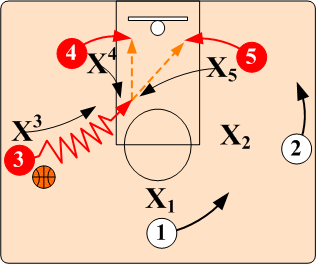
Drive & Drop
If a post defender steps out to help on the dribble penetration, the ball handler can make a drop pass to the post for an easy lay-up.
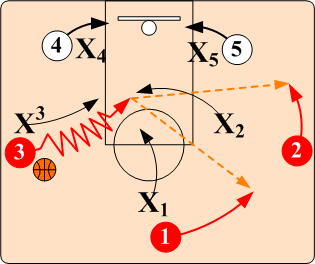
Drive & kick
When a wing defender sags off to help out against dribble penetration, the ball handler makes a kick out pass to the wide open spot up shooter.

ZONE ADJUSTMENTS
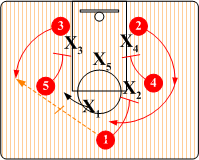
Since passing game action is predicated on ball movement, it can be ran against zone defenses very effectively with a few adjustments.
Man to man defense demands the use of quicker ball and player movement than zone defense.
Pass and screen less against zone.
Employ sharp accurate passing.
Receive the ball facing basket in a shooting stance.
Make the defense commit to the ball prior to passing.
Make use of the fake pass since zones move on the pass.
Cycle the defense. Attack the weak side of the zone. Use the skip pass frequently.
On high post exchange against zone, post should handle the ball at least twice before exchanging.
Look to dribble penetrate more into gaps and drop pass. Creates a two on one situation.
Post should try to come from behind defense to create leads.
On flash cuts into post, make move back to side from which you came (drop step).
Push the ball down the court. Beat the zone back. Once ball crosses half court, no more dribbling.
Get passing done early. "Get ball to open player."
Go to the boards. Take advantage of the lack of blocking out by zone defenses.
Maintain defensive balance at all times. Players in zone defenses are aligned according to fast break positions.

Coach’s Commitment & Benefits
In giving players the freedom to create, coaches may a feel a real loss of offensive control at first. However, as the season progresses, they will soon realize and appreciate the advantages and full potential of a non-structured offense. In addition, the Passing Game offense provides for the following added benefits:
Pressure of playing a low possession game takes away any room for mistakes. Most teams are not experienced with dealing with the tremendous mental pressure that occurs when every possession is vital to the outcome of the game. This pressure gets magnified even more during end of game crunch time.
Exposes and capitalizes on fundamentally weak defenders. Also, exposes any strong armed, inside players without outside defensive skills. Playing outside is a new adventure and they usually have no clue how to or the attitude to defend peripherally. Physically and mentally unprepared.
The easy shots that occur off back cuts against defensive overplays are very demoralizing to any defense.
Constant motion not only causes physical fatigue, but more importantly mental and spiritual fatigue. Prone to making physical and mental errors.
In and effort to speed up tempo, opponents tend to hurry and rush their shots. Turnovers are also increased by forcing and making difficult passes in the effort to speed up the game.
Dammed if you do, with back cuts. When they sag off, they loose all disruptive capabilities and are susceptible to ball control and good outside shooting.
Opponents conditioned to expect ball control tempo have a tendency to trot back on defense with backs to the ball making them vulnerable to easy transition baskets.
Slow tempo is bad for offensive team and individual player stats. Players with high stats can become very frustrated and discouraged when playing in a low possession game.
Opponents brained washed into thinking you are going to hold the ball, but in reality attacking the basket on every cut and pass. Forget to defend the basket. The threat of holding the ball, just like the threat of the dribble, is the Princeton Offense's best weapon.
-
Because of its patience and teamwork, the Passing Game is stable and steady night after night. It is never dependent on having a hot or cold shooting night from the field.
Return to Motion Offenses - Click Here
Return to Offensive Strategies - Click Here
Return to HoopTactics - Click Here
© 2026 HoopTactics All Rights Reserved.

